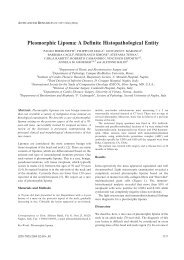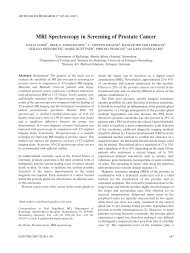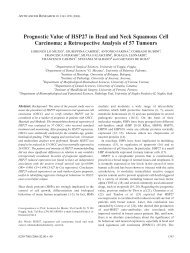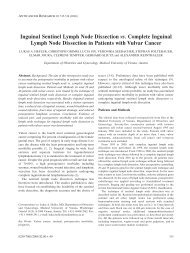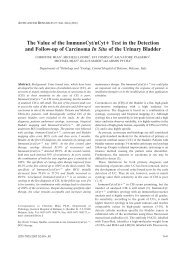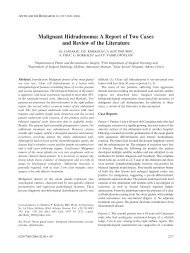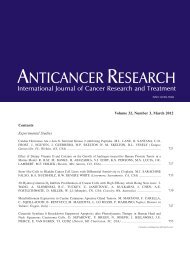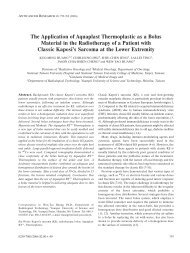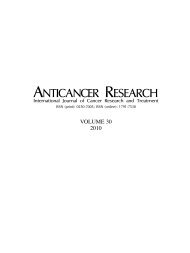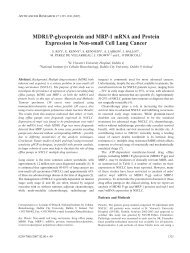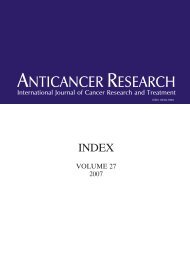ABSTRACTS OF THE 21st ANNUAL MEETING OF THE ITALIAN ...
ABSTRACTS OF THE 21st ANNUAL MEETING OF THE ITALIAN ...
ABSTRACTS OF THE 21st ANNUAL MEETING OF THE ITALIAN ...
You also want an ePaper? Increase the reach of your titles
YUMPU automatically turns print PDFs into web optimized ePapers that Google loves.
Table II.<br />
Median value<br />
3DCRT V40 V50 V60 V70 V72<br />
5-Field 65 55 40 25 20<br />
7-Field 60 38 30 23 20<br />
No G3 acute urinary toxicity was observed. Mild to moderate<br />
incontinence was reported in 2.5% of cases for each group,<br />
and urethral stenosis in 1.5% of the whole patient series. Table<br />
III shows cancer-specific survival (CSS), overall survival (OS),<br />
metastasis-free survival (MFS) and biochemical relapse-free<br />
survival (b-NED) at five and at ten years, after a median<br />
follow-up of 86.5 (range 25-142) months.<br />
Table III.<br />
Abstracts of the <strong>21st</strong> Annual Meeting of the Italian Society of Uro-Oncology (SIUrO), 22-24 June, 2011, Naples, Italy<br />
Parameter Five years Ten years<br />
CSS 99% 92%<br />
OS 94.1% 67%<br />
MFS 93.8% 80%<br />
b-NED 87% 77%<br />
Conclusion: 3DCRT technique can be considered a safe and<br />
effective treatment for patients affected by localized prostate<br />
cancer. The 7-field technique has a significantly better late<br />
rectal toxicity than 5-field 3DCRT. Although no correlation<br />
was found between dose-volume parameters and G3 late rectal<br />
toxicity, we suggest that a low dose of radiation therapy given<br />
to an extended rectal wall volume causes perfusion damage<br />
and represents the basis for mucosal ulcer and severe rectal<br />
bleeding.<br />
180<br />
RADICAL PROSTATECTOMY AND<br />
INTRAOPERATIVE RADIATION <strong>THE</strong>RAPY<br />
FOR CLINICALLY LOCALLY ADVANCED<br />
PROSTATE CANCER: CLINICAL ASPECTS<br />
AND RESULTS <strong>OF</strong> A PROSPECTIVE SERIES<br />
Giansilvio Marchioro 1 , Marco Krengli 2 , Alessandro Volpe 1 ,<br />
Matteo Vidali 3 , Roberto Tarabuzzi 1 , Stefano Zaramella 1 ,<br />
Michele Billia 1 , Francesco Varvello 1 , Monica Zacchero 1 ,<br />
Elisa De Lorenzis 1 , Andrea Ballarè 2 , Debora Beldì 2 ,<br />
Giuseppina Apicella 2 , Bruno Frea 4 and Carlo Terrone 1<br />
Departments of 1 Urology and 2 Radiotherapy Medicine and<br />
3 Clinical Chemistry Unit, Maggiore della Carità Hospital,<br />
University of Piemonte Orientale, Novara, Italy;<br />
4 Urology Department, Santa Maria della Misericordia<br />
Hospital, University of Udine, Udine, Italy<br />
Aim: Intraoperative radiation therapy (IORT) is a new<br />
technique that can deliver high doses of radiation during<br />
surgical treatment. Four years ago, we started a prospective<br />
feasibility study of IORT during radical prostatectomy (RP)<br />
for locally advanced prostate cancer (PCa). Here we report<br />
data on morbidity, toxicity (RTOG scoring criteria), functional<br />
and oncologic outcomes of our prospective series. Patients and<br />
Methods: From September 2005, 72 patients with locally<br />
advanced PCa were treated with IORT during RP. A total of<br />
67 patients had follow up ≥6 months. Inclusion criteria were:<br />
age 25% (Kattan’s nomograms) and no<br />
inflammatory bowel disease. During surgery, the prostate was<br />
exposed with dissection of endopelvic fascia and puboprostatic<br />
ligaments. The distance between the prostate and<br />
rectum was measured with ultrasound. A collimator<br />
(Mobetron, Intraop, California, U.S.A.) with a median<br />
diameter of 5.5 (range 4.5-7) cm and an angle ‘bevel’ of 15-<br />
30˚ was introduced into the surgical field and a dose of 10-12<br />
Gy with 9-12 MeV was delivered. The dose was prescribed to<br />
a 90% isodose. The volume treated included prostate, seminal<br />
vesicles and periprostatic area. RP was then completed and an<br />
extended lymphadenectomy was performed. Postoperative RT<br />
treatment three months after IORT, based on histological<br />
findings, was planned for 38/44 patients. A 3D conformal<br />
technique was used and a dose of 50 Gy (2 Gy/day) was<br />
delivered. Hormonal therapy (HT) was prescribed when<br />
indicated. Results: The median patient age was 67.2 (IQR<br />
62.3-73.0, min-max 51-75) years and median PSA at<br />
diagnosis was 21.8 (IQR 6.6-31.1, min-max 2.0-67.5) ng/ml.<br />
Biopsy Gleason score ranged from 4 to 9. A total of 23<br />
patients (35%) received neoadjuvant treatment. The majority<br />
of patients had clinically locally advanced PCa (78%). We<br />
observed no intra- or perioperative complications. The median<br />
dose absorbed by the rectum was 4.6 (range: 0.4-9.1) Gy.<br />
Pathological stage was: T2 in 21 patients, T3 in 40 patients<br />
and T4 in 5 patients. Positive lymph nodes were detected in<br />
17 patients (25.7%) and positive surgical margins (PSM) in 41<br />
patients (61%). A total of 56 patients (85%) underwent<br />
postoperative RT treatment, with a median follow-up of 24<br />
months (6-46). Rectal and urinary RT toxicity are detailed in<br />
Table I, according to the RTOG scale.<br />
Table I.<br />
N=66 Grade, N (%)<br />
Toxicity G0 G1 G2 G3<br />
Gastrointestinal, acute 52 (78.8) 7 (10.6) 6 (9.1) 1 (1.5)<br />
late 60 (90) 2 (3) 3 (4.5) 1 (1.5)<br />
Genitourinary, acute 44 (66.6) 13 (19.6) 8 (12.3) 1 (1.5)<br />
late 57 (86.5) 1 (1.5) 6 (9) 2 (3)<br />
1907



